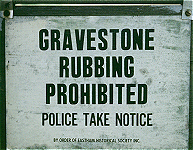


I am really just an amateur, but I have found that rubbings are a beautiful form of art. It is a fairly easy and inexpensive hobby that is a wonderful way to learn about history. There are some basic rules you should follow and some tools you need to get started. |
Rules:If you plan on doing rubbings of your family or relatives then some of these won't apply. I like to rub very old tombstones. They have a certain charm about them.
|
Tools:
|
MethodOnce you have found a nice tombstone you need to make sure it is clean. Use the soft brush and remove dirt and debris from the surface. Be gentle, and respectful, if the it looks as if you might scratch the tombstone then move on. After you get most of the dirt off spray it with the bottle and then wipe with the rag. Let the tombstone become perfectly dry before you go on. Cut the paper larger than the tombstone itself and wrap tightly aroundthe stone. Tape it very securely so that it doesn't move, if the paper moves when you start rubbing you will probably have to start over. Start rubbing on the outside edges and make yourself a frame of sorts. You don't need to rub real hard, you can always make it darker by going back over it but you can never make it lighter. You should start to see the patterns emerging at this point. Once you have the darkness down to you liking carefully spray the paper down with the Chalk spray. Be careful not to get any on the tombstone. When it is dry you can remove it and trim it in the shape of the stone or leave a border around it. This is all there is to it. Practice with it and develop your own style. I live in Texas and have found a couple of old cemeteries that are all but abandoned. The dates on a lot of these date back to the late 1800's. If you also live in Texas, E-mail me (rlupu29@iadfw.net) and I will give you directions. Remember the respect you show now will ensure that tombstone rubbing will always be looked at as a way to preserve history and not as vandalism. |
Caretaker's Notes:Avoid rubbing thin stones made of slate or sandstone. The pressure could well snap them in half. For the greatest safety, stick to granite. The Caretaker also wishes to thank Lydia Thompson, Carolanne Szoke, and other contributors to alt.society.funerary for their tips. Do you have samples of your own rubbings? Send me a gif or jpg. |


| Light Impressions - The Leading Resource for Archival Supplies |
| Virtual Tombstone Rubbings Using Impressionist |
| Questions or Comments? Return to the Taphophiles' Handbook |